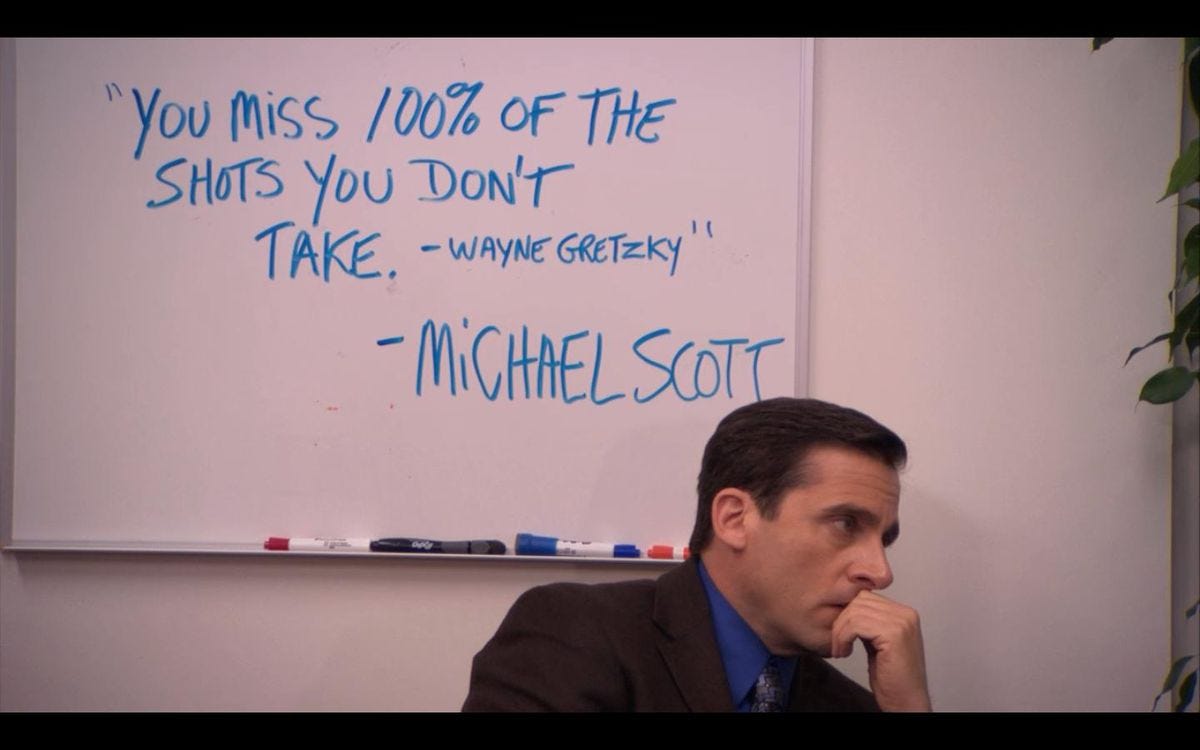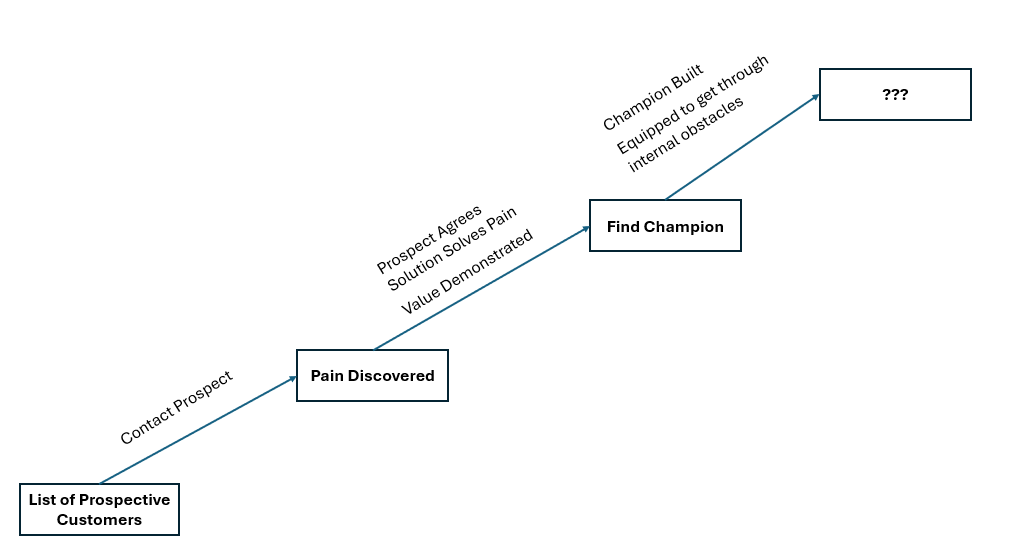Those who can sell will always have a massive advantage. Even if the idea of selling repels you, understanding how much of your life revolves around your ability to sell might change your perspective.
When you apply for a job, you need sell the hiring manager on why you are the best candidate. When you ask someone on a date, you need to make them believe you are worth their time. Numerous daily scenarios would be greatly improved by knowing how to sell.
I recently had the opportunity to spend time with a successful sales professional who has sold to some of the world's largest companies. During a week-long advisory stint with my company, he shared numerous insights. One key recommendation was to read The Qualified Sales Leader by John McMahon.
McMahon has held executive sales roles at several successful technology companies, including PTC, BladeLogic, BMC Software, and others. His expertise lies in building scalable sales processes, developing sales talent, and driving significant revenue growth, so he knows how to sell.
In this article and part II, I'll summarize the fundamental principles you need to understand to avoid being completely inept at selling. Today, I focus on convincing someone to want to buy your product; the next article will cover closing deals.
If you stop reading after this paragraph, here's what you need to do to get somebody to want to buy your product:
Understand why someone would buy your product or service.
Build a high-quality pipeline of prospects who are a great fit for what you offer.
Find your prospect's pain.
Demonstrate how you solve this pain.
Build internal advocates to help you make the sale.
Sounds simple, right? If you want to dive deeper, keep reading if not, have a great day!
You don’t need to be John McMahon or Jordan Belfort to understand that people buy to solve a want or need. Rational individuals don’t consciously decide to purchase something if neither condition is met. The effort that goes into a purchase varies depending on a few factors:
1) Cost: More expensive purchases involve more thought.
2) Complexity: More options and specific feature needs lead to more complex decisions
3) Frequency: Major, infrequent purchases (homes, cars, artwork) require more consideration than routine ones (gum, soda, lighters)
In B2B sales, vendors might seek millions of dollars to solve customer needs. Large enterprise software deals are among the most complex, involving numerous stakeholders and lengthy processes. The larger the company, the longer the sales cycle.
Salespeople, often called Account Executives (AEs), are assigned territories or segments and given sales targets. Their job is simple: Sell! Their performance is evident: hitting quotas means success, while missing them means failure. AEs reaching quota has implications beyond the sales team. If the sales team is hitting their quotas, everybody is getting paid and everyone is happy. If quotas are being missed, there will be consequences
Predictability is key. AEs want to know they can hit their quotas, and their managers want to assure their superiors of the same. Achieving consistent predictability is what The Qualified Sales Leader emphasizes.
To have sales predictability, a company needs at least 3 things:
The Right Team
Strong Pipeline Coverage
A Well Defined & Executable Sales Process
The Right Team:
The Wolf of Wall Street might lead you to believe that all it takes to close deals are well rehearsed sales pitches that can be taught to anybody. In reality, sales take a long time and trust needs to be built. Sales cycles do not generally start with C-Level Executives; the entry point is normally somebody lower on the org chart.
For a sale to proceed, they must be convinced to recommend to their boss, or their boss's boss that they need to allocate company resources for this product. They do not not want to waste people’s time or their department’s budget or they will look bad. You will have a short sales career if you make your customer advocates look bad.
This is why having the right people makes all the difference. A good salesperson needs to listen, communicate well, and appear competent/knowledgeable to build a strong connection with their prospects. They also need to be willing to work hard, since sales is a grind and they need to build or advance their pipeline every day.
Strong Pipeline Coverage
At the highest level, pipeline represents opportunities that have expressed some interest and has the potential to become a customer.
Each company will have their own specific criteria or definition of what they consider an opportunity, but in all cases you want as much high quality pipeline as possible.
Think of pipeline as shots on goal, if you take more shots, your chances of scoring go up. This is true in any sport. The reverse is also true, if you don’t shoot, you can’t score.
The best goal scorers in NHL history only scored on ~15% of their shot attempts, that meant they needed to take 7 shots to expect to score once1.
Getting 7 shots on goal every game is very difficult. No NHL player has ever been able to sustain this, even Alexander Ovechkin, the most prolific shot taker in NHL history, has only averaged 4.6.
(Notice how 8/10 of the NHLs all time Goal scorers were also in the top 10 in shots taken?)
Since getting 7 shots per game is not feasible, the focus needs to be on getting higher quality chances, so his shooting percentage would go up (getting him to score on 20% of his shots up from 13%)2.
Sales works exactly the same way.
If an AE wants to hit their quota, like Ovechkin, they need to figure out how they can get the most high quality scoring chances then determine how many qualified opportunities they need to have in a given quarter to be confident they will hit their quota. AEs that can generate pipeline in excess of that amount, give themselves additional margin for error. So basically, build as much good pipeline as possible.
AEs have a limited amount of time in a day and weeks in a quarter, therefore making sure they are not wasting time on bad prospects is as important as hockey players not wasting offensive possessions.
To do this, a sales team needs a well defined & executable sales process.
A Well Defined & Executable Sales Process
Having a great team and generating a lot of opportunities can help your company up to a certain point but eventually, competition, the economy or that annoying person in the finance department limiting budgets, will slow you down.
Sales leaders need to set their AEs up for success and this starts with common definitions.
First define who is your ideal customer by building an Ideal Customer Profile (ICP). An ICP is a specific description of the prospects most likely to buy your solution. This will generally have some combination of demographic information (company size, industry) as well as behaviors or attitudes.
A company selling software for dental clinics might realize some clinics are more in need of their solution than others.
The perfect prospect might look something like this:
At least 20 full time employees, 5 of which are dentists, have at least one full time administrative employee, at least 1,000 patients, sending out > 100 invoices per week, working with at least a dozen insurance carriers, currently working just in Excel or paper invoices. Etc.
The rationale is that the pain felt by a prospect becomes more visceral once they reach a certain size or if an activity happens frequently enough. A dentist won’t feel the need to look for a solution if they only spend 1 minute per day on administrative tasks but they will if they are spending upwards of 3 hours (that time can go towards serving more patients or working on their golf game, whichever pain they rather solve).
Start by understanding which prospects are most likely to purchase your solution, then prioritize targeting them. Going back to our hockey example, find out where you will most likely score from and spend most of your time there3.
If you have done a good job building your ICP, with a few decent discovery questions, these prospects will reveal this pain to you. If there is no pain there is no reason to buy from you. You can try your best to convince them there is pain but if it does not exist, your case will collapse once scrutinized.
Assuming there is pain, you will need to find somebody within your prospects organization to get the rest of the company to agree your solution is the best way to address it. This person is your Champion.
This is the most important definition in this entire article. A whole post could be written just about the proper definition around what a champion is or is not but at the most basic level, a champion is your advocate within your prospects organization, with authority or influence (both if you are lucky).
A champion needs to believe in what you are selling and be willing to use their power to help you advance through your deal stages. This is why it is important that they have at least some authority or influence, otherwise they cannot assist you in advancing the deal. If your point of contact lacks authority or influence, but wants you to win and assists you how they can, they are considered a coach.4
A common trap that Sales people fall into is that they believe they have a champion but in reality they only have a coach. Coaches can be valuable in helping you navigate a particular account but if you can't locate and win over a champion, you are not in control. If you are not in control of your deal, there is no way you can expect to win.
Champions are needed to win deals, they are the ones that will push and wrestle all the internal hurdles that stand in your way to get deals closed. As a vendor, you can’t be privy to all the internal discussions that happen, which is why you need the champion to be the one that advocates and pushes for you.
Why would a champion do this? They do this if they are convinced that the solution solves a major pain for their department/business. A champion will feel confident in this if the salesperson reassures them through proper discovery & scoping.
Discovery & Scoping
We established earlier that people buy to solve a want or a need. The more pressing this want or need is, the more painful it is to them and the more likely they are to want to buy. We mentioned the Dentist office spending 3 hours per day on admin work is more likely to want to purchase than the clinic spending one minute.
As a seller, your job is to understand your prospects' pain, and determine how your solution addresses it. Then you need to get the prospect to agree with you, and act on it. You need to play a combination of Sherlock Holmes, Doctor House and Don Draper.
In a B2B setting, there are 3 categories of pains your prospects are encountering:
How can they increase sales?
How do they reduce costs?
How do they protect themselves against risks?
Within these categories, they are trying to add new capabilities or improve existing processes (better efficiency or more resources).
It is easier to sell to somebody already aware of their problem and trying to address it, compared to trying to convince somebody not aware of it.
If you have a good handle of your ICP, you will know where to find the pain even before you speak to a prospect.
Start by understanding the current processes of the company (As-Is), then show what the new process with the solution will be (To-Be). Once you find the pain, you need to demonstrate how your company solves this pain AND is the best solution based on the prospects needs. This is an important step because if you have not shown why your solution is the best, you may have just sent a deal to one of your competitors.
If you have done a good job showing why your solution solves a real pain for the organization, a champion will emerge. The champion has many conflicting requests of their time and budget, therefore they need to strongly believe in your solution. Even if they believe in your product, they still have a lot of work to do to convince the rest of their organization.
This is why as a sales person, you need to work with your champion to understand their company's buying process and help equip them for all the questions, objections and steps that they will encounter before they can sign on the dotted line. If you have built a strong relationship and equipped your organization to handle potential internal objections, you are in a good place within your deal. If you can master these steps, this by itself will make it difficult to completely suck at sales, but there is still more work to do.
Today, we covered the fundamentals of why people buy, the importance of an Ideal Customer Profile (ICP), the necessity of a high-quality pipeline, and the skills needed to identify and address your prospect's pain points. We also explored the critical role of a Champion and how to equip them for success.
This is where we pause for now. In the next article, we’ll delve into transforming a qualified opportunity with a strong champion into a closed won deal.
If you aren’t already, please Subscribe so you don’t miss Part II and other great articles coming out each week.
Leading goal scorers in the NHL typically score around 50-60 times per regular season. Only 23 players in NHL history have scored 60 or more goals in a season, only 4 active players have ever done so.
Going back to the job opportunity example in the introduction, instead of applying for every job post on Linkedin, focus on the opportunities where you actually have the qualifications and you will likely hear back from a much higher percentage.
As one would expect, Higher Danger Scoring areas are those closest to the net
Back to the job application example, you won’t get offered the job unless the hiring manager thinks you are the best candidate for the job. Even if some of the other people you spoke to in the hiring process (Recruiter, other team members) like you, ultimately the hiring manager decides.










This feels like a masterclass on Sales. Detailed and on point. Thank you for sharing!
Great, detailed article, sales is critical for any org and these actionable steps can help them, which mechanisms have you used to identify their pains in the as-is process?